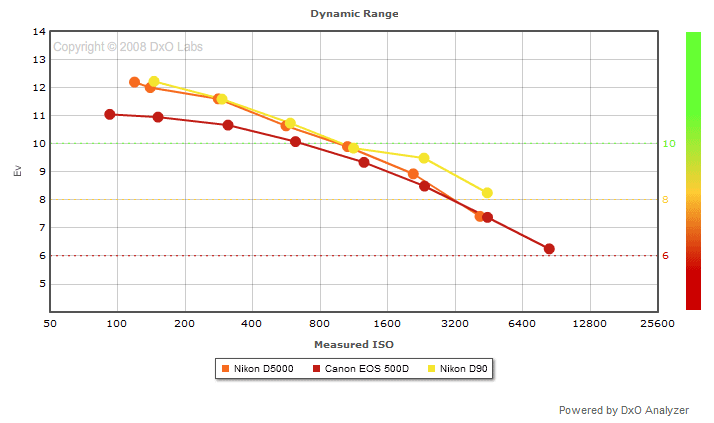|
Page 3 of 7
Resolution
The following chart compares the RAW and JPEG output of the Nikon D5000 to their direct competitors Canon EOS 500D and Olympus E-620,
as well as to their bigger sister Nikon D90 and to the effective resolution champions Panasonic DMC-L10 and DMC-G1. The results
are based on RAW files, transformed to DNG and converted to JPEG, using the same Adobe Camera RAW version.

The maximum resolution of the D5000's raw files is quite unspectacular and on a par with the nominally higher resolution of the Canon 500D. However the JPEG output is a good deal worse and no appropriate option if maximum resolution is needed.
As already mentioned in our Olympus E-620 preview,
the effective resolution of the Nikon D5000 is considerably higher comparing to the Oly due to the rather weak AA filter. The strong AA filter of the Olympus E-620 works out fine for eliminating moiree effects, but it has a negative impact on the resolution characteristic.
It's quite interesting that the comparatively big 3,73cm² sensor of the Nikon D5000 provides less effective resolution compared to the much smaller 2,25cm² sensor of the Panasonic G.
Let's check the impact of the pixel density of around 3.3 MP/cm² on the dynamic range...
Dynamic Range
"Dynamic range or light sensitivity range of a sensor indicates the ratio of light exposure between the highest brightness a camera can capture (saturation) and the lowest brightness it can effectively capture (typically when noise becomes more important than signal, i.e., SNR < 0 dB). This range indicates the maximum contrast that can be effectively captured by the sensor. The larger the dynamic range, the better, as the sensor is able to capture higher-contrast scenes.
Note that dynamic range is expressed on a logarithmic scale in EV (same as f-stop), thus an increase of 1EV corresponds to a doubling of dynamic range." (DxO Labs)
Here's an analysis by our partner, the (DxO Lab):

(DxO Labs)
While the dynamic range of 12 f-stops is excellent at low ISO, it decreases clearly recognizable by 2 f-stops in mid ISO range and drops below 8 f-stops at high ISO. The overall dynamic range of the Nikon D5000 is really good and up to ISO 1600 on par with
the Nikon D90.
Comparing to the Canon 500D, the dynamic range of the Nikon D5000 is about one f-stop bigger up to ISO 400 due to the lower pixel density before it falls finally in line with its competitor.
The following figure illustrates this fact...

Imagine the photodiode of a sensor to be a sort of light cavity, where the photons can be "stored" (measured). A sensor with lower pixel density
has bigger light cavities than a sensor with higher pixel density. The bigger light cavities can store more photons than
smaller once and therefore store a higher contrast ratio, e.g. 4000:1 photons to 1000:1 photons.
This means, generally dynamic range is higher for digital cameras with lower pixel density due to larger pixel size.
Of course digital cameras can not count single photons, but they can measure the black level, the brightness at the darkest
part of an image. This darkness is limited by image noise and this is the reason why dynamic range is higher at low ISO.
|